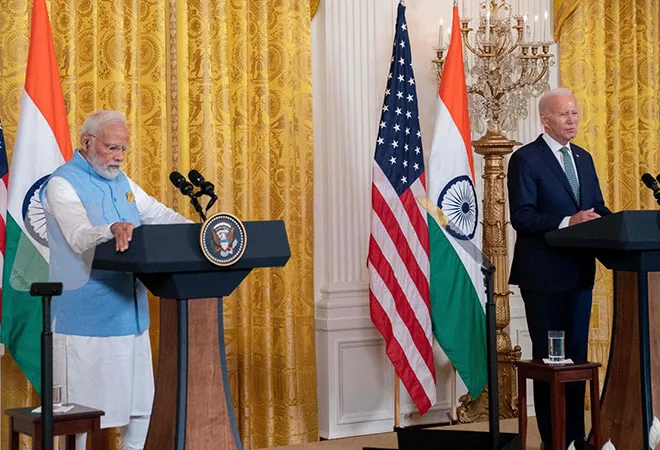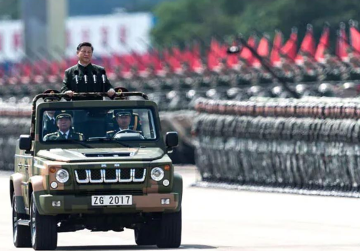
Prime Minister Modi’s first official
state visit to the United States (US), has generated palpable excitement in India's strategic community. The tour is being viewed as a
turning point in US-India ties and a transformational moment in the larger bilateral strategic relationship. The Prime Minister’s address to a joint session of the US Congress was a moment of pride for many Indians, which was described by many as an affirmation of India’s rise on the global stage.
The
big-ticket defence contracts, in particular the deal for the manufacture of jet engines in India, have generated the most excitement. In an
announcement on 21 June, GE Aerospace confirmed that it has signed a memorandum of understanding (MoU) with Hindustan Aeronautics Limited (HAL) to co-produce F414 jet engines in India for the Indian Air Force. India and the US also concluded an agreement for the
purchase of 31 armed US MQ-9B Sea Guardian (Predator) drones made by General Atomics worth US$3 billion.
While Indian processes prioritised high technologies at low cost, the US system sought to limit the export of such dual-use technology that could endanger US national security.
These outcomes are the result of weeks and months of coordination and planning. Since May 2022, when India and the US announced an initiative to share vital and emerging technology (iCET), Indian and US officials have been hard at work to evolve, improve, and refine an operational framework. During a visit to New Delhi earlier this month, US Defence Secretary Lloyd Austin
discussed opportunities for expanded defence-industrial cooperation to co-produce and co-develop military platforms and hardware. Days before the Prime Minister’s visit to the US, Indian National Security Advisor, Ajit Doval, and his American counterpart, Jake Sullivan, unveiled a
roadmap for enhanced collaboration in high-technology areas, with a focus on addressing regulatory barriers to deepen collaboration in critical areas such as semiconductors, next-generation telecommunication, artificial intelligence (AI), and defence.
Even so, a significant impediment to India-US defence engagement remains. In the past, Washington and New Delhi seemed motivated by
different objectives in their defence technology cooperation. While Indian processes prioritised high technologies at low cost, the US system sought to limit the export of such dual-use technology that could endanger US national security. Today, despite a shared desire to do more together in the defence technology space, the imperatives on both sides largely remain the same. India continues to face budgetary pressures, and American companies are still fighting to keep China and Russia from stealing their proprietary technologies.
Notwithstanding the positive developments in recent days, in particular the deal for the joint manufacture of the F-414 engine, the threshold for the export of dual-use technologies in the US remains high. Notably, the MoU for the joint manufacture of the jet engine offers little clarity on the specifics of the critical technologies to be transferred. The US Department of Commerce which controls all transfers of critical technology through the International Traffic in Arms Regulations (ITAR) is reportedly still in the
process of creating and approving a package for the F414. GE;
some say it is unlikely to transfer full technology or even release details of the deal unless a commercial contract is finalised.
What the Indian Navy needs for combat conditions are nuclear submarines and underwater unmanned drones, but those technologies are not on offer.
With the sale of MQ-9 (Sea Guardian/Predator) drones, also, there are questions. Priced at US$3 billion, the deal is expensive, especially when seen in light of the fact that drones offer little more than air and surface surveillance capability. As this analyst pointed out in a
recent paper, unmanned aerial vehicles have limitations in submarine detection and anti-submarine warfare. Sea conditions, sensor platform speed, and geomagnetic and geological noise significantly impact the magnetic and electro-optical sensors, reducing the drones' ability to locate deep-diving submarines. Despite its enhanced endurance and multiple payload packages, the Sea Guardian is a big, slow-moving drone and
vulnerable in contested environments. What the Indian Navy needs for combat conditions are nuclear submarines and underwater unmanned drones, but those technologies are not on offer. The armed ‘Predator’ drones, with their laser-guided bombs and hell-fire missiles, seem more capable of deterring incursions on India’s land border with China and Pakistan. But here, too, it's unclear how these platforms, successful in permissive environments, will be employed in more contested and complex airspaces.
Importantly, the acquisition of MQ-9 drones is under the US government’s
Foreign Military Sales (FMS) programme, which fast-tracks equipment and platform sales to friendly countries but does not necessarily facilitate the sharing of critical know-how. Acquisitions under the programme have rarely resulted in the transfer of technology because the US government does not presume to act on behalf of US defence companies that own their intellectual property. The latter are highly protective of their crown jewel assets, which they do not part with unless required to do so by a commercial agreement with a foreign partner. One could
argue that regulatory changes in US export control, following iCET, will facilitate the transfer of technology. Yet, US defence firms remain answerable only to their shareholders, whose motivations are largely commerce-driven. American defence companies will ultimately transfer only the technology that India can afford.
Similarly, with the F-414 deal, there remain questions. The critical issue from an Indian perspective is not whether the US will offer more technology than earlier. Washington’s keenness to make amends for the failings of the Defense Technology and Trade Initiative (DTTI), in particular, the
abrupt termination in 2019 of a US-India joint project to develop jet engines, is apparent. The question is whether the transfer of technology this time around will include the jet engine core. The Biden administration’s efforts to ease defence sale norms—laudable as they are—may not be enough to convince GE to
transfer hot turbine technology to HAL.
Beyond the geopolitical payoff, America’s embrace of India is driven by a desire to wean the Indian armed forces off Russian arms imports.
The foregoing is not meant to downplay the importance of the India-US technology sharing agreements. The structural reasons that sustain bilateral defence technology collaboration are clear and compelling. The goal is to resist Chinese expansionism in the Indo-Pacific, where the US and India are major stakeholders. Strategically, New Delhi and Washington are justified in seeking the tools to deter and dissuade Beijing. US efforts to engage in
adaptive diplomacy with India are also understandable. Beyond the geopolitical payoff, America’s embrace of India is driven by a desire to wean the Indian armed forces off Russian arms imports. It is sobering, however, that America’s seeming strategic altruism is contingent—at least in part —on the
prospect of US companies winning Indian tenders to manufacture air force fighter jets and carrier-borne fighters.
It may be prudent, then, to recognise the limits of possibility in the US-India defence technology partnership. As Admiral Arun Prakash
remarked last week, India's decision-makers ought to reflect on the reality that no state or corporation willingly shares valuable technology. Unless contact details are carefully negotiated, foreign corporations will frequently misrepresent ‘licenced production’ as technology transfer. Notwithstanding the benefits of deeper strategic alignment with the US, New Delhi should know that the political and financial costs of cooperation with Washington remain high. Modi’s moment in the American sun certainly needs to be celebrated, but Indian officials and experts must temper their exuberance with a touch of realism.
Abhijit Singh is Head of the Maritime Policy Initiative at the Observer Research Foundation
The views expressed above belong to the author(s). ORF research and analyses now available on Telegram! Click here to access our curated content — blogs, longforms and interviews.



 Prime Minister Modi’s first official
Prime Minister Modi’s first official  PREV
PREV


